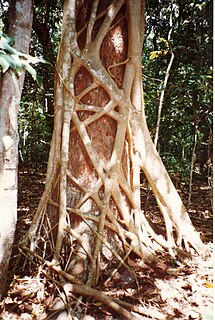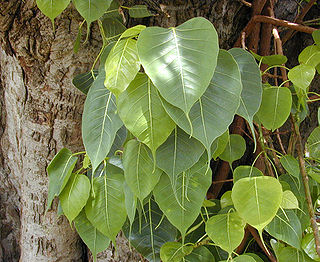
Ficus is a genus of about 850 species of woody trees, shrubs, vines, epiphytes and hemiepiphytes in the family Moraceae. Collectively known as fig trees or figs, they are native throughout the tropics with a few species extending into the semi-warm temperate zone. The common fig (F. carica) is a temperate species native to southwest Asia and the Mediterranean region, which has been widely cultivated from ancient times for its fruit, also referred to as figs. The fruit of most other species are also edible though they are usually of only local economic importance or eaten as bushfood. However, they are extremely important food resources for wildlife. Figs are also of considerable cultural importance throughout the tropics, both as objects of worship and for their many practical uses.

Ficus macrophylla, commonly known as the Moreton Bay fig or Australian banyan, is a large evergreen banyan tree of the family Moraceae native to eastern Australia, from the Wide Bay–Burnett region in the north to the Illawarra in New South Wales, as well as Lord Howe Island. Its common name is derived from Moreton Bay in Queensland, Australia. It is best known for its imposing buttress roots.

Ficus microcarpa, also known as Chinese banyan, Malayan banyan, Indian laurel, curtain fig, or gajumaru (ガジュマル), is a tree in the fig family Moraceae. It is native in a range from China through tropical Asia and the Caroline Islands to Australia. It is widely planted as a shade tree and frequently misidentified as F. retusa or as F. nitida.

Strangler fig is the common name for a number of tropical and subtropical plant species, including some banyans and unrelated vines, including among many other species:

Ficus religiosa or sacred fig is a species of fig native to the Indian subcontinent and Indochina that belongs to Moraceae, the fig or mulberry family. It is also known as the bodhi tree, pippala tree, peepul tree, peepal tree, pipal tree, or ashvattha tree. The sacred fig is considered to have a religious significance in three major religions that originated on the Indian subcontinent, Hinduism, Buddhism and Jainism. Hindu and Jain ascetics consider the species to be sacred and often meditate under it. This is the tree under which Gautama Buddha is believed to have attained enlightenment. The sacred fig is the state tree of the Indian states of Odisha, Bihar and Haryana.
Ficus schumacheri is a species of tree in the family Moraceae. The species is monoecious.

Ficus nota is a species of flowering plant in the family Moraceae. It is commonly known as tibig or sacking tree, is a species of fig tree found near water in low altitudes. Tibig is native to the Philippines. They are also found in parts of northern Borneo in Malaysia.The tree can grow up to 9 meters high. It is primarily dispersed by birds which eat the fruits and excrete the seeds. The fruits are also edible to humans, although they are rather bland. They are usually eaten with sugar and cream in the Philippines. The young leaves are also eaten as a vegetable.
Ficus crassiuscula is a species of flowering plant in the family Moraceae, native to Central America and north-western parts of South America.

Ficus aurea, commonly known as the Florida strangler fig, golden fig, or higuerón, is a tree in the family Moraceae that is native to the U.S. state of Florida, the northern and western Caribbean, southern Mexico and Central America south to Panama. The specific epithet aurea was applied by English botanist Thomas Nuttall who described the species in 1846.
Ficus maxima is a fig tree which is native to Mexico, Central America, the Caribbean and South America south to Paraguay. Figs belong to the family Moraceae. The specific epithet maxima was coined by Scottish botanist Philip Miller in 1768; Miller's name was applied to this species in the Flora of Jamaica, but it was later determined that Miller's description was actually of the species now known as Ficus aurea. To avoid confusion, Cornelis Berg proposed that the name should be conserved for this species. Berg's proposal was accepted in 2005.

Ficus insipida is a common tropical tree in the fig genus of the family Moraceae growing in forest habitats along rivers. It ranges from Mexico to northern South America.

Ficus americana, commonly known as the West Indian laurel fig or Jamaican cherry fig, is a tree in the family Moraceae which is native to the Caribbean, Mexico in the north, through Central and South America south to southern Brazil. It is an introduced species in Florida, USA. The species is variable; the five recognised subspecies were previously placed in a large number of other species.

Ficus obliqua, commonly known as the small-leaved fig, is a tree in the family Moraceae, native to eastern Australia, New Guinea, eastern Indonesia to Sulawesi and islands in the southwestern Pacific Ocean. Previously known for many years as Ficus eugenioides, it is a banyan of the genus Ficus, which contains around 750 species worldwide in warm climates, including the edible fig. Beginning life as a seedling, which grows on other plants (epiphyte) or on rocks (lithophyte), F. obliqua can grow to 60 m (200 ft) high and nearly as wide with a pale grey buttressed trunk, and glossy green leaves.

Ficus pseudopalma is a species of fig in the family Moraceae. It is known by the common names Philippine fig, dracaena fig, and palm-leaf fig. In nature it is endemic to the Philippines, especially the island of Luzon. It is known elsewhere as an ornamental plant.

The Ficus sansibarica, known as knobbly fig, is an African species of cauliflorous fig. It is named after Zanzibar, where Franz Stuhlmann discovered it in 1889. They often begin life as epiphytes, which assume a strangling habit as they develop. They regularly reach 10 m, but may grow up to 40 m tall as forest stranglers.

Ficus palmata, the Punjab fig, or "Bedu" is a plant in the family Moraceae.
Ficus triloba is an Asian species of fig tree in the family Moraceae. It is dioecious, with male and female flowers produced on separate individuals.
Ficus assamica is a species of flowering plant in the genus Ficus, native to the foothills of the Himalayas, Assam, south-central China, and mainland Southeast Asia. It is a recumbent or creeping shrub reaching at most 60 cm.
A tree in the Moraceae family, Ficus bernaysii is found from New Guinea to the Solomon Islands, growing in lowland rainforest. It is dioecious, and grows cauliflorous fruit. It is fed on by a wide range of animals.
Ficus scabra is a fig species in the family Moraceae native to Fiji, New Caledonia, Niue, Samoa, Tonga, Vanuatu, and Wallis-Futuna Island in the southwestern Pacific.












